Explore the best cycling and bike touring routes in Raleigh, from scenic greenways to wooded trails and smooth city rides—perfect for a vacation on two wheels.
HOW DO I HANDLE TECHNICAL DESCENTS IN MOUNTAIN BIKING?
For beginners and experienced riders alike, technical descents are among the most thrilling—and intimidating—parts of mountain biking. They demand a mix of skill, confidence, and precision to navigate steep terrain, loose rocks, roots, and tight corners. Poor technique can lead to crashes or missed lines, while good technique transforms descents into exhilarating, controlled rides. This article breaks down the fundamentals of body positioning, braking, and line choice, alongside mental strategies and drills that help riders handle technical descents safely and smoothly. By mastering these elements, mountain bikers gain speed, control, and confidence to tackle challenging trails.

The importance of body positioning
Body position is the foundation of control when descending technical terrain. The correct stance distributes weight effectively, absorbs trail impacts, and ensures the rider remains stable and balanced. Without it, even the best braking or line choices will fail.
Neutral and attack positions
The neutral position is used on moderate descents or smoother sections. It involves level pedals, slightly bent knees and elbows, and relaxed grip. The attack position, however, is for steep or technical drops. Here, the rider shifts hips back, lowers chest closer to handlebars, and stays light on the pedals to react quickly to obstacles.
Weight distribution and balance
A common beginner mistake is leaning too far back or locking arms stiffly. Effective descending requires dynamic weight shifts: moving hips slightly back for steep grades but keeping enough weight on the front wheel to maintain traction and steering control. Flexed joints act like suspension, absorbing trail chatter while keeping the bike planted.
Keep pedals level for stability
Bend elbows and knees for shock absorption
Look ahead, not down at the wheel
Stay loose to let the bike move under you
Developing instinctive body positioning is key to unlocking confidence on technical descents. Practice on moderate slopes before progressing to more challenging terrain.
Braking and choosing lines
Descending technical terrain is not about brute force; it’s about precision. Braking and line selection are the tactical tools that dictate whether a descent feels smooth and controlled—or chaotic and risky.
Controlled braking techniques
Many riders panic and grab a fistful of brakes on steep descents, causing skids or loss of control. The correct technique is feathering—light, controlled pressure on both brakes, with emphasis on the front brake for stopping power and the rear for stability. Braking should occur before entering technical features, not while rolling over them.
Reading terrain and line selection
Choosing the right line means scanning ahead and anticipating obstacles. Look 2–3 meters forward, not directly at the front wheel. Pick smoother paths when available, but also learn to ride over rocks and roots confidently. Avoid target fixation—staring at hazards often leads to hitting them.
Brake before corners or drops, not during
Use front brake for 70% of stopping power
Scan trail ahead for best lines
Trust momentum to carry over obstacles
Effective braking and smart line choice reduce energy waste, preserve speed, and create a sense of flow, turning intimidating descents into manageable challenges.
Confidence and progression strategies
Technical descents test not only skill but also mental resilience. Fear and hesitation are natural, but with structured practice, riders can turn nervous energy into controlled confidence.
Progressive skill-building
Start with smaller descents, gradually increasing steepness and technicality. Drills such as braking practice on gravel, bunny hops over small roots, or cornering sessions in controlled settings build transferable skills. Repetition builds muscle memory, making reactions automatic under pressure.
Mindset and visualization
Mental preparation is equally important. Visualization—imagining a clean descent—reduces anxiety and primes body coordination. Breathing techniques help relax grip and reduce stiffness. Riding with skilled peers also accelerates learning, as observing others’ lines provides real-time lessons.
Practice drills in safe environments before tackling harder trails
Use visualization and breathing to reduce fear
Ride with more experienced partners for guidance
Progress step by step to avoid overwhelming crashes
Confidence comes from combining technical skills with mental readiness. Over time, what once felt intimidating becomes second nature, unlocking the full joy of mountain biking descents.
YOU MAY ALSO BE INTERESTED






